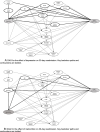Depressive symptoms and malnutrition are associated with other geriatric syndromes and increase risk for 30-Day readmission in hospitalized older adults: a prospective cohort study
- PMID: 35918652
- PMCID: PMC9344637
- DOI: 10.1186/s12877-022-03343-6
Depressive symptoms and malnutrition are associated with other geriatric syndromes and increase risk for 30-Day readmission in hospitalized older adults: a prospective cohort study
Abstract
Background: Readmission in older adults is typically complex with multiple contributing factors. We aim to examine how two prevalent and potentially modifiable geriatric conditions - depressive symptoms and malnutrition - relate to other geriatric syndromes and 30-day readmission in hospitalized older adults.
Methods: Consecutive admissions of patients ≥ 65 years to a general medical department were recruited over 16 months. Patients were screened for depression, malnutrition, delirium, cognitive impairment, and frailty at admission. Medical records were reviewed for poor oral intake and functional decline during hospitalization. Unplanned readmission within 30-days of discharge was tracked through the hospital's electronic health records and follow-up telephone interviews. We use directed acyclic graphs (DAGs) to depict the relationship of depressive symptoms and malnutrition with geriatric syndromes that constitute covariates of interest and 30-day readmission outcome. Multiple logistic regression was performed for the independent associations of depressive symptoms and malnutrition with 30-day readmission, adjusting for variables based on DAG-identified minimal adjustment set.
Results: We recruited 1619 consecutive admissions, with mean age 76.4 (7.9) years and 51.3% females. 30-day readmission occurred in 331 (22.0%) of 1,507 patients with follow-up data. Depressive symptoms, malnutrition, higher comorbidity burden, hospitalization in the one-year preceding index admission, frailty, delirium, as well as functional decline and poor oral intake during the index admission, were more commonly observed among patients who were readmitted within 30 days of discharge (P < 0.05). Patients with active depressive symptoms were significantly more likely to be frail (OR = 1.62, 95% CI 1.22-2.16), had poor oral intake (OR = 1.35, 95% CI 1.02-1.79) and functional decline during admission (OR = 1.58, 95% CI 1.11-2.23). Malnutrition at admission was significantly associated with frailty (OR = 1.53, 95% CI 1.07-2.19), delirium (OR = 2.33, 95% CI 1.60-3.39) cognitive impairment (OR = 1.88, 95% CI 1.39-2.54) and poor oral intake during hospitalization (OR = 2.70, 95% CI 2.01-3.64). In minimal adjustment set identified by DAG, depressive symptoms (OR = 1.38, 95% CI 1.02-1.86) remained significantly associated with 30-day readmission. The association of malnutrition with 30-day readmission was no longer statistically significant after adjusting for age, ethnicity and depressive symptoms in the minimal adjustment set (OR = 1.40, 95% CI 0.99-1.98).
Conclusion: The observed causal associations support screening and targeted interventions for depressive symptoms and malnutrition during admission and in the post-acute period.
Keywords: Depression; Malnutrition; Older adults; Readmission.
© 2022. The Author(s).
Conflict of interest statement
The authors have no conflict of interest to declare.
Figures
References
Publication types
MeSH terms
LinkOut - more resources
Full Text Sources
Medical



